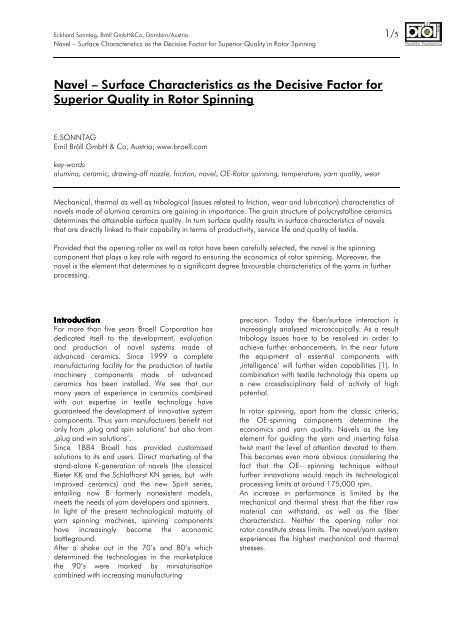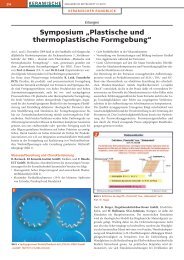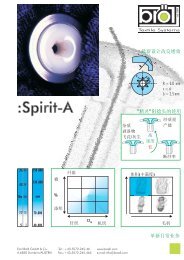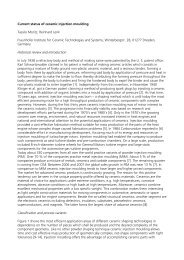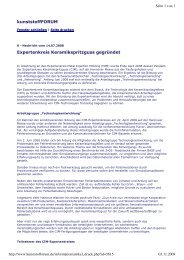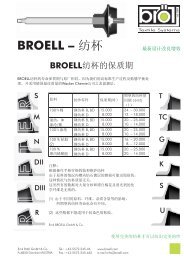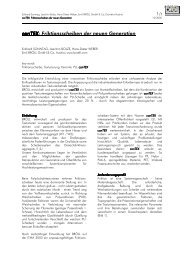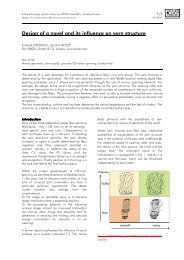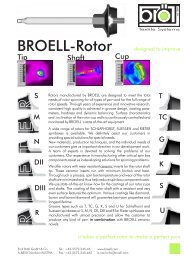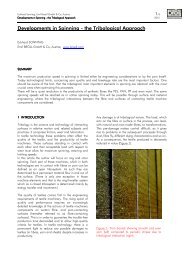Ad1-Internetartikel english
Ad1-Internetartikel english
Ad1-Internetartikel english
Create successful ePaper yourself
Turn your PDF publications into a flip-book with our unique Google optimized e-Paper software.
Eckhard Sonntag, Bröll GmbH&Co, Dornbirn/Austria 1/5<br />
Navel – Surface Characteristics as the Decisive Factor for Superior Quality in Rotor Spinning<br />
Navel – Surface Characteristics as the Decisive Factor for<br />
Superior Quality in Rotor Spinning<br />
E.SONNTAG<br />
Emil Bröll GmbH & Co, Austria; www.broell.com<br />
key-words<br />
alumina, ceramic, drawing-off nozzle, friction, navel, OE-Rotor spinning, temperature, yarn quality, wear<br />
Mechanical, thermal as well as tribological (issues related to friction, wear and lubrication) characteristics of<br />
navels made of alumina ceramics are gaining in importance. The grain structure of polycrystalline ceramics<br />
determines the attainable surface quality. In turn surface quality results in surface characteristics of navels<br />
that are directly linked to their capability in terms of productivity, service life and quality of textile.<br />
Provided that the opening roller as well as rotor have been carefully selected, the navel is the spinning<br />
component that plays a key role with regard to ensuring the economics of rotor spinning. Moreover, the<br />
navel is the element that determines to a significant degree favourable characteristics of the yarns in further<br />
processing.<br />
Introduction<br />
Introduction<br />
For more than five years Broell Corporation has<br />
dedicated itself to the development, evaluation<br />
and production of navel systems made of<br />
advanced ceramics. Since 1999 a complete<br />
manufacturing facility for the production of textile<br />
machinery components made of advanced<br />
ceramics has been installed. We see that our<br />
many years of experience in ceramics combined<br />
with our expertise in textile technology have<br />
guaranteed the development of innovative system<br />
components. Thus yarn manufacturers benefit not<br />
only from ‚plug and spin solutions‘ but also from<br />
‚plug and win solutions‘.<br />
Since 1884 Broell has provided customised<br />
solutions to its end users. Direct marketing of the<br />
stand-alone K-generation of navels (the classical<br />
Rieter KK and the Schlafhorst KN series, but with<br />
improved ceramics) and the new Spirit series,<br />
entailing now 8 formerly nonexistent models,<br />
meets the needs of yarn developers and spinners.<br />
In light of the present technological maturity of<br />
yarn spinning machines, spinning components<br />
have increasingly become the economic<br />
battleground.<br />
After a shake out in the 70’s and 80’s which<br />
determined the technologies in the marketplace<br />
the 90’s were marked by miniaturisation<br />
combined with increasing manufacturing<br />
precision. Today the fiber/surface interaction is<br />
increasingly analysed microscopically. As a result<br />
tribology issues have to be resolved in order to<br />
achieve further enhancements. In the near future<br />
the equipment of essential components with<br />
‚intelligence‘ will further widen capabilities [1]. In<br />
combination with textile technology this opens up<br />
a new crossdisciplinary field of activity of high<br />
potential.<br />
In rotor spinning, apart from the classic criteria,<br />
the OE-spinning components determine the<br />
economics and yarn quality. Navels as the key<br />
element for guiding the yarn and inserting false<br />
twist merit the level of attention devoted to them.<br />
This becomes even more obvious considering the<br />
fact that the OE- spinning technique without<br />
further innovations would reach its technological<br />
processing limits at around 175,000 rpm.<br />
An increase in performance is limited by the<br />
mechanical and thermal stress that the fiber raw<br />
material can withstand, as well as the fiber<br />
characteristics. Neither the opening roller nor<br />
rotor constitute stress limits. The navel/yarn system<br />
experiences the highest mechanical and thermal<br />
stresses.<br />
Emil Emil Bröll Bröll GmbH GmbH &<br />
&<br />
Co. Co. Holzstr.1 D-<br />
73650 Winterbach
Eckhard Sonntag, Bröll GmbH&Co, Dornbirn/Austria 2/5<br />
Navel – Surface Characteristics as the Decisive Factor for Superior Quality in Rotor Spinning<br />
Figure 1 shows correlation between friction<br />
temperature and surface of ceramic navels<br />
Comparison Comparison between between between ceramics ceramics ceramics and and steel steel<br />
steel<br />
Ceramics are made of finely dispersed raw<br />
materials that, once put into the desired shape,<br />
are exposed to a high temperature treatment.<br />
Diffusion processes and chemical reactions that<br />
take place during this treatment will determine<br />
their characteristics. Ceramics react with brittle<br />
fracture behaviour after initial almost linear elastic<br />
behaviour [2].<br />
Dense in technical terms, pure polycrystalline<br />
A1 2 0 3 is free of pores (theor. Dens. 3.985 gr/cm 3 )<br />
and exhibits a thermal conductivity of around<br />
33 W/mK and a strength of HV0.05 =<br />
2500 N/mm 2 . A ductile highly coated steel<br />
(density of 7.85 g/cm 3 ) has a thermal conductivity<br />
of around 15 W/mK, whereas the strength of high<br />
quality nitride steel is HV0.05 = 800 –<br />
1100 N/mm 2 [3,4]. Strength characteristics<br />
correlate with resistance to wear. However, the<br />
quoted thermal conductivity broadly contradicts<br />
observed practices! Experience teaches us that<br />
steel navels are preferable when it comes to the<br />
treatment of thermally sensitive fibers due to better<br />
fiber and yarn protection characteristics. However,<br />
this does not necessarily have to be the case as<br />
shown in the following.<br />
While developing navels and surfaces at Broell<br />
three rules that are universally applicable to all<br />
fiber materials have been formulated. These rules<br />
have been established by microscopic analysis<br />
and the condition over time of distinct surface<br />
markings of navels, independent of the working<br />
material, and these rules are as follows:<br />
1.) The fiber / yarn is unforgiving. Any<br />
previous damage will have a negative<br />
impact on its subsequent processing.<br />
2.) There are two options: either the textile<br />
will shape the navel surface or the navel<br />
surface will shape the textile.<br />
3.) Every imperfection found on the navel<br />
surface limits the potential of the fiber,<br />
yarns and spinning process in terms of<br />
quality and productivity.<br />
Steel navels – irrespective of good or bad initial<br />
surface structure- will be permanently ‚polished‘<br />
by the yarn. This results from the inherent<br />
properties of steel. As a consequence the<br />
replacement of a steel navel is due to<br />
unacceptable deformation of the polished surface<br />
by waves (material displacement). There is a<br />
strong departure from the initial geometry due to<br />
wear. Wash-out effects and distortion of the<br />
groove design happens – under the prerequisite<br />
that grooves exist. This goes hand in hand with a<br />
loss in spinning stability and deterioration in yarn<br />
quality.<br />
A mirror-like surface is imperative for navels made<br />
of ceramics. Navel smoothening due to the<br />
spinning process does not occur when alumina is<br />
used – exactly the opposite effect will take place if<br />
the material structure does not possess optimal<br />
wear resistance and if it does not allow any<br />
flexibility. In that case it leads to either mono or<br />
polycrystallinity and thus to eruption of sharpedged<br />
grains. Ceramic experts describe this<br />
phenomenon as intercrystalline wear. The<br />
underlying reason is the high- frequency periodic<br />
oscillation behaviour of the yarn on the navel<br />
surface. Frequencies greater than 100 kHz are no<br />
exception – even for navels without grooves. The<br />
higher the frequency the higher are the forces<br />
acting on the navel surface (‚whip impact‘). This<br />
explains the untimely development of clearly<br />
visible chatter marks on steel navels caused by<br />
plastic grain deformation.<br />
Figure 2 shows a comparison of worn out steel<br />
navel vs. worn out ceramic navel<br />
Emil Emil Bröll Bröll GmbH GmbH GmbH &<br />
&<br />
Co. Co. Holzstr.1 D-<br />
73650 Winterbach
Eckhard Sonntag, Bröll GmbH&Co, Dornbirn/Austria 3/5<br />
Navel – Surface Characteristics as the Decisive Factor for Superior Quality in Rotor Spinning<br />
Compared to steel, navels made of ceramics are<br />
brittle hard. However, they have the ability to<br />
exhibit equivalent favourable tribological<br />
behaviour towards yarn as steel navels, given the<br />
right material structure and surface.<br />
Requirements Requirements for for navels navels from from a a tribology<br />
tribology<br />
point point of of view<br />
view<br />
Requirements in terms of tribology can be<br />
grouped under three headings:<br />
1.) long service life: fit for constant<br />
productivity<br />
2.) fiber and yarn protection: fit for yarn<br />
quality and problem-free further<br />
processing<br />
3.) yarn and material look: fit for fashion<br />
and quality standards<br />
In practice, an increase in productivity always<br />
depends on a decrease in yarn breaks and an<br />
increase in delivery speed. The latter can be<br />
achieved by reducing yarn twist. However, in this<br />
case the navel needs a pronounced false twist<br />
effect. Due to the potential loss of elongation, an<br />
increase in rotor speed can only be achieved by a<br />
reduction in (dynamical) yarn tension – therefore<br />
the geometric characteristics of navel and rotors<br />
are more decisive.<br />
It is commonly understood that man-made fibers<br />
are more aggressive towards the surface of navels<br />
than clean cotton. However, if cotton contains<br />
trash and sand, faster wear can be observed. The<br />
effect of the navel surface on man-made fibers is<br />
clearly greater than that on cotton fibers which<br />
are covered by a wax and pectin layer.<br />
Furthermore consistent dyeing is a challenge for<br />
chemical as well as for natural fibers caused by<br />
excessive thermodynamical stress at the navels.<br />
Figure 3 shows emerging speed of yarn on<br />
surface of navel.<br />
Figure 3 shows emerging speed of yarn on<br />
surface of navel.<br />
At a rotor speed of 120,000 rpm the yarn moves<br />
and rotates more than 2,000 times per second on<br />
the navel surface. The resultant speed of about<br />
6,000 meters per minute, measured at the very<br />
edge of the navel, makes it clear that we are<br />
dealing with a speed an order of magnitude<br />
higher than is reached by twisted yarns anywhere<br />
else in the textile world. Therefore much attention<br />
has to be paid to the choice of the right spin finish<br />
alone.<br />
A wise saying known in the world of textile<br />
tribology states that it is always favourable to<br />
provide a rough textile surface with a smooth<br />
(processing) surface (and vice versa!). Spun staple<br />
fibers are classified as rough textiles in this case.<br />
As a consequence a brightly polished navel<br />
surface is imperative in order to reduce friction.<br />
However, polishing does not help in reducing<br />
textile damaging pores as demonstrated by the<br />
following figure:<br />
Figure 4: Polishing does not eliminate pores on<br />
ceramic surfaces.<br />
A reduction in the number of pores requires<br />
compaction of the material structure. The material<br />
density should be as close as possible to the<br />
theoretical maximum achievable density (point of<br />
reference: > 99.5% of theoretical maximum<br />
density). Only a slight decrease in ceramic density<br />
from 99.5% to 99.0% of the theoretical maximum<br />
density can provoke an increase in friction from u<br />
= 0.2 to u = 0.7. Through effects explained in<br />
the following discussion, measured yarn values<br />
will suffer considerably.<br />
Where Where does does does wear wear on on navels navels take take place?<br />
place?<br />
Seen in yarn running direction, wear on a navel<br />
becomes first visible on the top left of the grooves<br />
and on the groove entrance. Hence, this is where<br />
Emil Emil Bröll Bröll GmbH GmbH GmbH &<br />
&<br />
Co. Co. Holzstr.1 D-<br />
73650 Winterbach
Eckhard Sonntag, Bröll GmbH&Co, Dornbirn/Austria 4/5<br />
Navel – Surface Characteristics as the Decisive Factor for Superior Quality in Rotor Spinning<br />
the highest mechanical yarn impulses occur.<br />
Another zone, which is also highly loaded in<br />
grooveless navels, can be found between about<br />
45 and 60° to the doffing direction. It is here that<br />
the highest contact pressure and relative speed<br />
and therefore highest thermodynamic stresses<br />
prevail.<br />
How How do do navels navels wear wear out?<br />
out?<br />
If a high quality navel is distinguished by an<br />
impressive surface luster then worn out navels of<br />
average quality ceramic can be identified by their<br />
dull surface caused by an increasing number of<br />
pores. Investigations of actual practice revealed<br />
that, depending on quality demands of spinning,<br />
an increase in number of pores by a factor of 2 to<br />
50 compared to the initial state is tolerated before<br />
a navel is replaced. The reason is the<br />
disintegration of the ceramic grains. The<br />
disintegration of grains at (sharp-edged) pores is<br />
even more drastic. As a consequence holes<br />
measuring 50 to 100 um emerge very quickly<br />
which can easily be detected on the navel surface<br />
by a practictioner with the help of a pin.<br />
Figure 5: Fiber cemetery as a result of<br />
intercrystalline wear at the groove entry (high<br />
staff-values)<br />
The The pore pore is is the the root root of of all all all evil<br />
evil<br />
The purity of the alumina, the maximum density<br />
achieved and the surface quality, shape the<br />
properties of navels. The purity of monodisperse<br />
alumina should amount to a minimum of 99.7%.<br />
Alumina of that purity is of white to ivory colour.<br />
The higher the level of material purity, the so<br />
much higher is the<br />
- intercrystalline strength and overall<br />
strength<br />
- hardness<br />
- thermal conductivity (alumina of 99.7%<br />
purity still attains merely 85% of its<br />
potential thermal conductivity)<br />
- corrosion resistance<br />
The last criterion plays a particularly important<br />
role for processing of man-made fibers. For<br />
alumina with a low level of purity the silicate<br />
substances act as “cement between grains”.<br />
However, these glass phase declines due to<br />
chemical-mechanical attacks. Moreover the glass<br />
phase acts as a thermal insulator around each<br />
grain.<br />
The density serves as an indicator for achieved<br />
quality of surface. Every discrepancy to a smaller<br />
value in ceramic density results from defects of<br />
grain structure. In the best case, pores are closed<br />
and spread evenly throughout the alumina .<br />
However, during polishing of the surface these<br />
closed pores will turn into open pores. Today the<br />
specification for final density lies at 3.92 gr/cm 3 .<br />
An increase in final density from 3.92 to<br />
3.96 gr/cm 3 reduces the number of defects by<br />
300 to 400%! In other words, yarn has to face<br />
about 5,000 defects of 50 um diameter on the<br />
convex surface for a classical four notch navel<br />
and will face 1,000 pores for a navel at 3.96<br />
gr/cm 3 density.<br />
Once a pore approaches the dimensions of the<br />
fiber or even the yarn it is called a microscopic<br />
defect. On the one hand a (closed) pore<br />
represents a heat insulator thus reducing thermal<br />
conductivity by deviating from the ideal density .<br />
On the other hand (open) pores of such<br />
dimension are the origin of wear. Thirdly, the pore<br />
on the surface acts as a depot in this case.<br />
Abraded fiber constituents conglomerate thereby<br />
increasing friction on the yarn which in the end<br />
can make spinning impossible – in contrast to<br />
mechanical engineering (where pores filled with<br />
lubricant can be of a big benefit in reducing<br />
friction).<br />
Emil Emil Bröll Bröll GmbH GmbH GmbH &<br />
&<br />
Co. Co. Holzstr.1 D-<br />
73650 Winterbach
Eckhard Sonntag, Bröll GmbH&Co, Dornbirn/Austria 5/5<br />
Navel – Surface Characteristics as the Decisive Factor for Superior Quality in Rotor Spinning<br />
Figure 6: A pore in the ceramic structure and<br />
respective fibre dimensions<br />
Ceramic Ceramic wear wear vs. vs. textile textile characteristics<br />
characteristics<br />
The life cycle of a navel varies according to<br />
stresses imposed on it as well as to the<br />
requirements of the spinner or downstream<br />
processor. Usually the life cycle of navels is 6 to<br />
48 months. Extreme examples just underpin<br />
demanding quality standards. The rotor yarn is<br />
located in the region of the navel for 5 to 15 turns<br />
of the rotor . Independent of delivery speed a yarn<br />
touches every 1 to 2 mm the same region of the<br />
navel surface or touches the same potential<br />
defects. If the type of wear is purely<br />
transcrystalline (smooth wear through the grain)<br />
the navel will act as favourably as a steel navel. If<br />
wear is intercrystalline, microfractures will appear<br />
around sharp-edged grain boundaries – resulting<br />
in at least a significant increase in Staff (fly) values<br />
as well as mostly a loss in yarn tenacity.<br />
Figure 7: Time dependence of Staff (fly) values as<br />
indicator for wear of the navel<br />
Variations from position to position can be limited<br />
by a more precise positioning between metal<br />
holder and ceramic navel. This is where another<br />
development by Broell Corporation comes in: the<br />
ceramic press fit, as it guarantees the highest<br />
possible centering not only between ceramic<br />
navel and holder but simultaneously between face<br />
plate and rotor.<br />
As a positive secondary effect press fit enhances<br />
thermal conductivity of ceramics and holder.<br />
Moreover press fit does not need any thermal<br />
isolating glue thereby eliminating the risk of glue<br />
residue sticking on the navel or the flying out of<br />
the navel into the rotor itself. Finally, at the same<br />
time the procedure of pressing acts as a quality<br />
gate as flawed ceramics do not pass this stage.<br />
Summary Summary and and and conclusion<br />
conclusion<br />
The differences between alumina ceramics are as<br />
diverse as they are for steel. Number and size of<br />
pores detected on a surface of a navel indicate<br />
the level of achieved density of the alumina<br />
structure. The purity of the ceramic determines the<br />
strength of grain boundaries. The smaller the<br />
grain the more ductile is the ceramic. Taking<br />
these parameters into account from the early<br />
stages of the development process is the best way<br />
to achieve high production navels for OE<br />
spinning: navels that are characterized by high<br />
resistance to wear combined with favourable<br />
behaviour in terms of development of wear, a<br />
lower yarn friction while simultaneously providing<br />
higher thermal conductivity. By this means proven<br />
increases in productivity of 5 – 15 % are<br />
attainable. Top economic efficiency with<br />
microfibers, from high productivity of OE yarns, is<br />
achievable by applying such a highly advanced<br />
navel design together with attaining the highest<br />
possible rotation speed of rotors when processing<br />
man-made fibers.<br />
In the context of “nanosizing” more positive<br />
characteristics of ceramics can be revealed and<br />
benefited from in the future.<br />
Sources Sources<br />
Sources<br />
[1] Sonntag, E.: Developments in Spinning –<br />
the Tribological Approach, Tribology 2000 -Plus,<br />
12th Int. Trib.-Colloquium, Jan.11-13th, 2000,<br />
Vol.3, 1565-1569 as well as www.broell.com<br />
[2] Gräfen, H.: Lexikon der Werkstofftechnik,<br />
VDI-Verlag, Düsseldorf 1991<br />
[3] Rohde, M.; Schulz,B.: The Effect of the<br />
Exposure to Different Irradiation Sources on the<br />
Thermal Conductivity of Al203, Journal Nuclear<br />
Materials 173 (1990), S.289<br />
[4] Touloukian, Y.: Thermophysical<br />
Properties of Matter, Vol.2, Plenum Press, N.Y.,<br />
1970<br />
more infos: e.sonntag@broell.com<br />
Emil Emil Bröll Bröll GmbH GmbH GmbH &<br />
&<br />
Co. Co. Holzstr.1 D-<br />
73650 Winterbach


